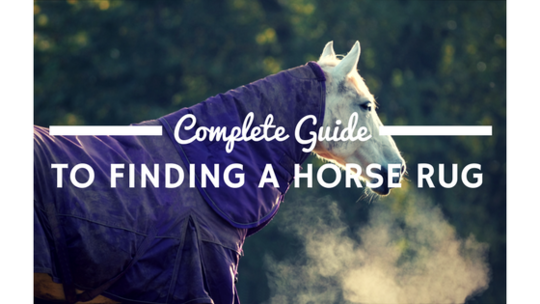
Are You & Your Horse Ready For Bitting Advice? The Steps You Need To Consider First
Equestrian Advice & Guides All Disciplines
Build your business profile for FREE and expose your services to thousands of potential clients!
Create my profile now!
Comfort is one of the most important factors to think about whether you’re riding or your horse is in the stable, so choosing the right rug for you and your horse is essential. Sizes, weights and materials vary for every rug on the market so there’s certainly plenty to think about. We’ve compiled all the talking points into one guide, so that you no longer have such a pressing dilemma!
Check out Equine Superstores great range of rugs here, including Weatherbeeta.
When your horse is out of the stable you’ll need something to keep them comfortable, dry and warm. A turnout rug is the ideal solution as they tend to be very waterproof, hard-wearing and have good cooling systems. Turnout rugs are split into several different categories to help identify the rug you require. Throughout the coldest parts of winter you should probably keep your horse or pony in a heavyweight rug which are between 300g to 400g fill. The extra fill here allows more heat to be contained, therefore staying warmer. As the weather gets nicer you would probably replace this with a medium weight rug that is usually filled to around 200g. These choices will also depend on the conditions you have kept your horse in throughout the year. If they have been fully clipped and stabled throughout winter then you will need a heavier weight rug as they may get cold even during the warmer months. The varying weights may also affect a horse's mobility too, as the heavier a rug is the harder it will be for them to move around freely, so it’s up to you to decide how much freedom your horse needs.
Size and weight are equally important as each other. Whilst the weight of a rug determines its warmth and mobility, size will affect its comfort and effectiveness. If a rug is too small, it may be quite restricting on your horse and could put their muscles and joints under excessive stress. At the same time, a rug too big just won’t be serving any purpose, it might let heat out and could get caught up in a horse's legs. Thinking about size and weight carefully will ensure that you find a perfect rug - this applies to all rug types and not just turnouts!
This rug really is what is says on the tin - a less compact rug with varying fill, used for when your horse is in the stable. Similarly to the turnout, stable rugs come in contrasting thicknesses to suit the conditions as well as different breeds. Unlike the above, stable rugs are for indoor use only as their waterproofing abilities are not so good.
A stable rug is an essential piece of kit for any horse owner alongside the turnout, as even the most secure stable can sometimes fail to keep the elements away. This rug allows your horse or pony to stay warm all day, every day no matter what the conditions are in the stable.
Summer Sheets
The summer sheet is a slightly less essential piece of gear but is still strongly recommended. When the weather gets warmer in the summer your horse may spend a lot more time out of the stable. Although many people may opt to not have a rug at this time of year, your horse can still get irritated by things like flies, dust and dirt, so a summer sheet is in your best interests. It is extremely lightweight and usually cotton, helping to keep your horse cool, circulate air and prevent any unwanted attention.
Leaving a horse in a thicker turnout rug in the summer could put them in serious danger of overheating, which can lead to more critical illnesses.
This is another summer based rug, but with the primary commitment of insects and flies away. The fly rug is made from mesh instead which makes it extremely breathable and a more seamless design. You can purchase fly rugs with full body coverage (neck, belly and tail) also for complete protection against pests.
This is one of the more versatile pieces of equipment as it can be used in conjunction with other rugs or as a handy substitute. A coolers' breathability makes it a great option for cooling down after exercise; providing both warmth and active circulation. Its fleeced design makes it compatible as a light stable rug too, as it keeps the horse warm but not dry. In much colder conditions the fleece rug doubles up as an underlayer for heavyweight or mediumweight rugs, to provide a more secure, snug warmth. Its prime function is post exercise recovery and is a wardrobe must have for any rider.
A show sheet is a more premium item of horse clothing that is used by competition riders. Its sleek, lightweight design makes it ideal for being active and on the go. Not only this but they are made with style and appearance in mind making them the most attractive attire on the market. Their bespoke finishes and striking colour schemes aim make you and your horse the stars of the show.
Almost seen as a step down from the show sheet, the exercise sheet is another more active and mobile piece, except with everyday usage in mind. It is built with a more durable design to prevent wear and tear from constant use. It is also slightly warmer with more filling so that your horse will remain dry and warm. This increases the comfort and prevents rubbing so that your horse can ride for longer. A versatile sheet that is perfect for any horse owner.
An ill fitted rug will not only look strange but will also be very uncomfortable for your horse. Too big and it will rub and chafe, causing pressure on the chest and issues of slippage. Too small and it will dig in and cause a lot of discomfort.
To ensure a great fit, just follow these simple steps!
From the centre of the horse’s chest, ideally where the top chest buckle would sit, measure in a straight line around the shoulder, along the belly to the furthest point of the rump. Exclude the tail from your measurements as that will add unnecessary length to your rug and it will not fit. This measurement will give you a guide size for your rug. Don’t be afraid to measure more than once to clarify. The last thing you want is to order a rug that will cause your horse any discomfort. Rug measurements tend to increase by 3” each size. If your measurements fall between, it is always better to go up a size.
Why not try measuring an existing rug that you know fits as well?Ideally you should measure a thin rug, such as a cotton sheet as this will give you a more accurate sizing. Make sure that you actually measure the rug rather than just take what it says on the label as truth. Chances are, your rug will have changed size since you purchased it.
When choosing a rug, as well as the size, you should also consider the time of year in which the horse will be using this rug. This way you can alter the weight to be in line with the weather conditions. You do not want your horse in a thick rug during warmer months as this will make them uncomfortable and they are likely to try to escape it, leaving you with a very muddy and damaged horse rug.
When your horse is wearing the rug, you will want to ensure that it fits properly and there are a number of ways for you to see if it is incorrectly fitted. For example, if you have a turnout or stable rug and it extends beyond the top of your horse’s tail, then it is too big. You will also want to make sure that your horse has its head down when you are checking this, as this will pull the rug forward into the correct position. If the rug doesn’t even reach the top of the tail then it is too small.
When you are fitting the rug to your horse, you will want to adjust the leg straps along with the surcingles in order to allow a hand’s width between the strap and the horse’s body or leg. This will allow your horse a bit more freedom and comfort. If you do not take this measure, then your horse could get his legs caught in the straps or could rub.
The front straps should also be adjusted, in order to ensure that the top of the rug sits nicely in front of the wither. If it fits behind it, then it can pull back and cause suffering to your horse in the shape of rubbing or sores. You should also be able to easily insert your hand down the front of the rug and you should also see that it is mobile enough to move your hand backwards and forwards over the horse’s coat.
If the neck of the rug is too large, then it will most probably hang off the back of the horse, which can put pressure on the animal’s shoulders and again, can cause rubbing.
That is all the information you need to find the perfect collection of rugs for you and your horse. Take a look below for a short recap, or visit our Ultimate Health Guide for even more tips and advice.


